The Lincoln Memorial Penny represents the lowest denomination produced by the U.S. Mint and holds a unique place in American numismatic history. As the first circulating U.S. coin to feature a real person—President Abraham Lincoln—it has remained popular among collectors for over a century.
While earlier issues are often highly collectible and more valuable, later dates like 1981 are generally more affordable due to their high mintage and widespread circulation. However, coins in exceptional condition or with notable mint errors can still command premium prices in the collector market.
1981 Lincoln Penny Value Chart
| Condition | 1981 No Mint Mark Penny | 1981-D Penny | 1981-S Type 1 Proof Penny | 1981-S Type 2 Proof Penny |
|---|---|---|---|---|
| MS 65 | $14 | $20 | / | / |
| PR 65 | / | / | $4 | $26 |
🔍 Note: “MS” refers to Mint State (uncirculated) grades, while “PR” refers to Proof coins. Type 1 and Type 2 are two distinct varieties of the 1981-S proof penny.
History of the 1981 Penny

The Lincoln cent is one of the most iconic and widely collected coins ever issued by the United States Mint. First introduced in 1909 to commemorate the 100th anniversary of Abraham Lincoln’s birth, it replaced the Indian Head cent and marked a significant shift in American coinage.
A Historic First
Designed by Victor David Brenner, the original coin featured Lincoln’s portrait on the obverse and two wheat stalks on the reverse—earning it the nickname “Wheat Penny.” This coin was revolutionary: it was the first U.S. coin to depict a real person, breaking with the tradition of using allegorical figures like Lady Liberty or stylized Native Americans.
Design Changes Over Time
While the obverse design has remained relatively unchanged, the reverse has seen two major redesigns:
- 1959: To celebrate the 150th anniversary of Lincoln’s birth, designer Frank Gasparro introduced a new reverse depicting the Lincoln Memorial. Uniquely, Lincoln’s statue appears between the memorial’s columns, making it the first U.S. coin to feature the same person on both sides.
- 2009 and Beyond: The Memorial reverse was retired in 2008, and a series of new designs followed in 2009 to honor Lincoln’s bicentennial.
1981 Lincoln Penny Types and Mintages
| Mint Location | Type | Mintage |
|---|---|---|
| Philadelphia | 1981 No Mint Mark Penny | 7,491,750,000 |
| Denver | 1981-D Penny | 5,373,235,677 |
| San Francisco | 1981-S Proof Penny (Type 1 & 2) | 4,063,083 |
| Total | — | 12,869,048,760 |
Composition and Transition
Up until 1981, Lincoln cents were struck in an alloy of 95% copper and 5% tin or zinc. However, due to rising copper prices, the U.S. Mint shifted to a copper-plated zinc composition starting in 1982. As a result, 1981 was the final year for the traditional high-copper penny, marking the end of an era for collectors and historians alike.
Features of the 1981 Penny
The obverse of the 1981 Lincoln penny
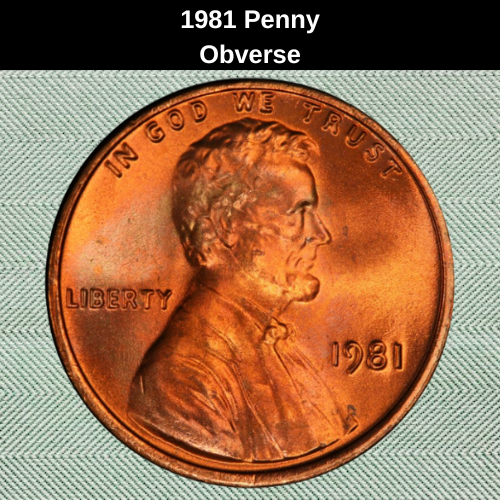
The obverse of the Lincoln cent prominently features the bust of the 16th President of the United States, Abraham Lincoln. His right-facing profile is centered on the coin and shows him dressed in a formal coat, shirt, and tie, capturing his dignified and presidential presence.
Along the upper rim is the national motto “IN GOD WE TRUST.” To the left of the portrait, near Lincoln’s shoulder, appears the word “LIBERTY.” On the right side, in front of the bust, is the year of minting, accompanied by the mint mark, if applicable. Notably, coins struck at the Philadelphia Mint do not bear a mint mark.
The reverse of the 1981 Lincoln penny
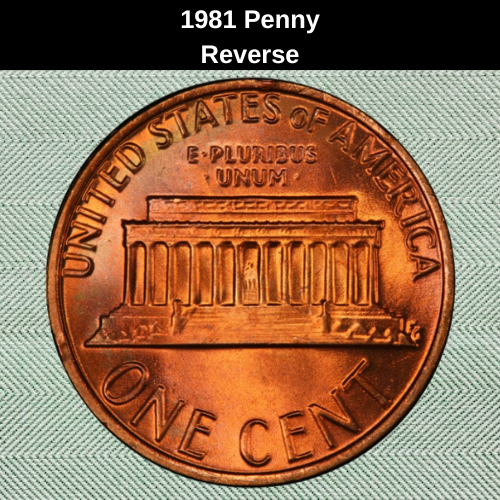
The reverse of the 1981 Lincoln penny features the iconic Lincoln Memorial, supported by twelve visible columns. If observed closely, one can see the seated figure of Abraham Lincoln positioned between the central pillars—a tribute to the statue housed within the actual memorial.
Above the structure, the Latin motto “E PLURIBUS UNUM” (meaning “Out of many, one”) is inscribed. The phrase “UNITED STATES OF AMERICA” arches along the upper rim, while the coin’s denomination, “ONE CENT,” is prominently displayed at the bottom rim, beneath the steps of the Memorial.
To the right of the Memorial steps, the initials “FG” represent the designer, Frank Gasparro.
1981 Lincoln Penny Specifications:
- Face Value: $0.01 (One Cent)
- Composition: 95% copper, 5% zinc
- Diameter: 0.75 inches (19 mm)
- Thickness: 0.06 inches (1.5 mm)
- Weight: 0.11 ounces (3.11 g)
- Shape: Round
- Edge: Plain
Other Features of the 1981 Lincoln Penny
The 1981 Lincoln penny is composed of 95% copper and 5% zinc, consistent with the alloy used in most U.S. cents minted before the composition change in 1982. This coin features a round shape with a plain edge.
Key physical specifications include:
- Diameter: 0.75 inches (19 mm)
- Thickness: 0.06 inches (1.5 mm)
- Weight: 0.11 ounces (3.11 g)
These dimensions and composition align with the standard specifications for Lincoln cents produced during this era.
1981 Lincoln Penny Grading
A coin’s grade plays a crucial role in determining its value. Authorized experts assess Lincoln pennies using the Sheldon Grading Scale, which evaluates factors such as color, luster, strike quality, and preservation. The better the condition, the higher the grade—and the greater the value to collectors.
Below is a breakdown of the standard grading system:
| Grade Number | Grade Description |
|---|---|
| 1 | Basal State-1 |
| 2 | Fair |
| 3 | Very Fair |
| 4–6 | Good |
| 7–10 | Very Good |
| 12–15 | Fine |
| 20–30 | Very Fine |
| 40 | Extremely Fine |
| 50 | About Uncirculated (AU) |
| 60 | Mint State (MS) |
| 65 | Gem Mint State (MS) |
| 70 | Perfect Mint State (MS) |
To determine the exact value of your 1981 Lincoln penny, it is essential to reference a grading guide or consult a professional coin grading service. This ensures accuracy and helps you understand where your coin fits on the scale.
1981 Penny Value Guides
1981 No Mint Mark penny value
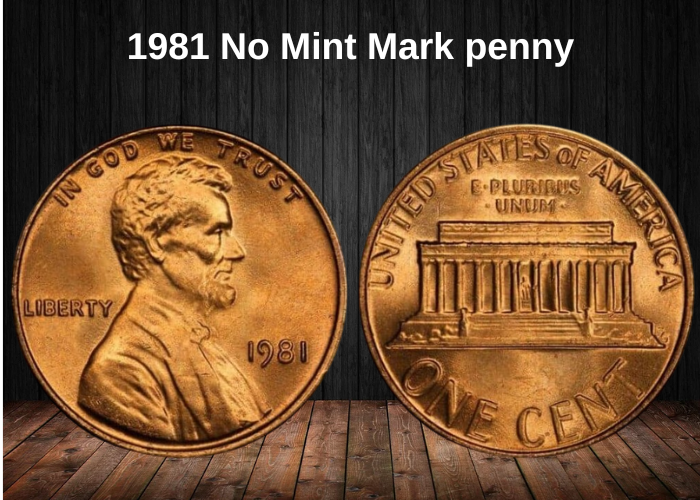
The Philadelphia Mint struck 7,491,750,000 Lincoln Memorial pennies in 1981. None of these coins carry a mint mark, which is typical for Philadelphia-struck cents of this era. Due to the extremely high mintage, most of these coins remain common and are still found in circulation.
Value by Condition (Red Specimens):
| Grade | Estimated Value |
|---|---|
| Circulated (Average) | $0.01 (face value) |
| MS 60 | $0.20 |
| MS 65 | $14 |
| MS 66 | ~$36 |
| MS 67 | ~$215 |
Coins that achieve higher grades and maintain strong red color (RD designation) tend to command much higher premiums at auction. Some MS 67 RD specimens have fetched between $700 and $3,000, depending on eye appeal and strike quality.
1981 D Penny
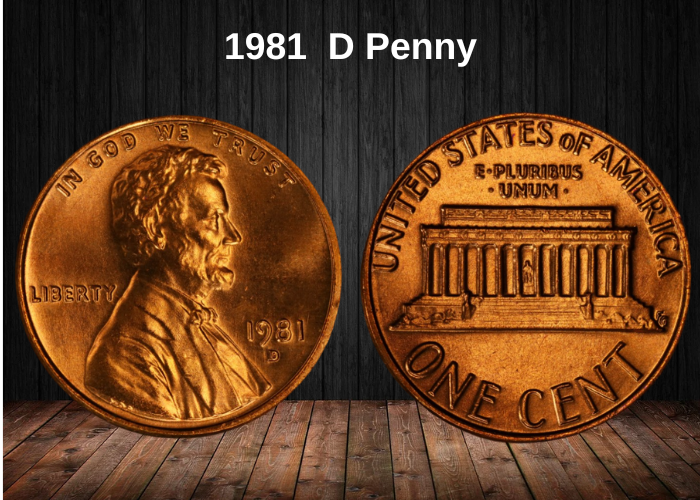
In 1981, the Denver Mint produced 5,373,235,677 Lincoln Memorial pennies, identifiable by the “D” mint mark on the obverse. Despite this large mintage, these coins remain common and are easily found in everyday circulation.
Value by Condition (Red Specimens):
| Grade | Estimated Value |
|---|---|
| Circulated (Average) | $0.01 (face value) |
| MS 60 – MS 65 | Up to $20 |
| MS 66 | ~$26 |
| MS 67 | ~$160 |
| MS 67+ (Auction Record) | $5,170 (achieved in 2017 for a red MS 67+ specimen) |
While most 1981-D pennies hold only nominal value unless in superb condition, those with top-tier mint state grades and brilliant red color (RD designation) can command significant premiums at auction.
1981 S proof penny value
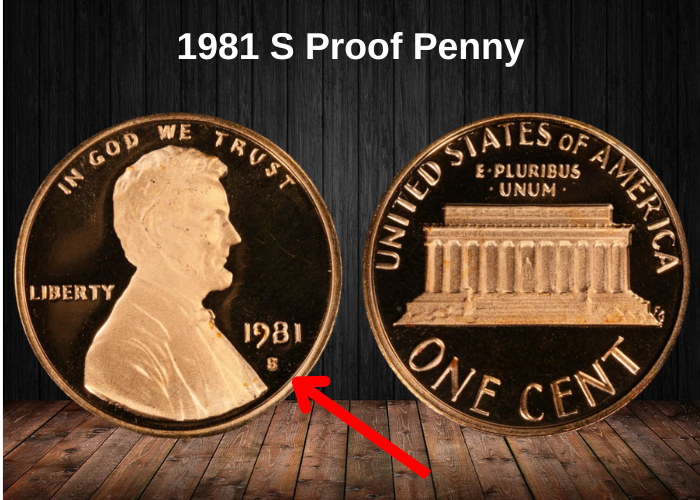
The 1981-S Lincoln proof pennies were minted at the San Francisco Mint, with a total mintage of 4,063,083 coins. These coins are easily identified by the “S” mint mark on the obverse.
Types of 1981-S Proof Pennies:
- Type 1 (Filled S or “Filed S”): The S mint mark appears bold or filled due to die wear.
- Type 2 (Clear S): The S is sharply struck and thinner, resulting in a more refined appearance.
Value Guide for 1981-S Proof Pennies (Deep Cameo/DCAM)
| Grade | Type 1 (Filed S) | Type 2 (Clear S) |
|---|---|---|
| PR 60–PR 65 | Up to $4 | ~$15 |
| PR 66–PR 67 | $5–$6 | $18–$52 |
| PR 68 | — | ~$65 |
| PR 69 | — | ~$200 |
Auction Records:
- Type 1: A PR 70 DCAM specimen sold for $8,050 in 2003.
- Type 2: A high-grade example sold for $863 in 2004.
Rare 1981 Penny Errors List
Despite strict quality controls, errors can still appear during the minting process. Some errors are obvious, while others require magnification or special equipment to detect. Collectors highly prize error coins, often paying premiums that can reach tens of thousands of dollars.
Here are some of the well-known errors found on 1981 Lincoln pennies:
Doubled Die Error (DDO)
- Cause: Occurs when the coin die receives a double impression during the hubbing process.
- Appearance: Partial or full doubling of letters, numbers, or design elements on the coin’s surface, especially visible on the date and lettering.
- Value: Prices vary from about $37 up to $150, depending on the error’s severity and coin grade.
- Where to find: Often available on auction sites like eBay and specialized coin auctions.
Die Break
- Cause: Results from the die cracking or breaking during the striking process.
- Appearance: Raised lines, scratches, or irregular marks on the coin surface where the die broke.
- Value: Can be highly valuable; for example, a brown 1981 penny with a die break error in MS 64 grade recently sold for nearly $700.
- Notes: The size and visibility of the die break affect the coin’s worth.
Off-Center Strike
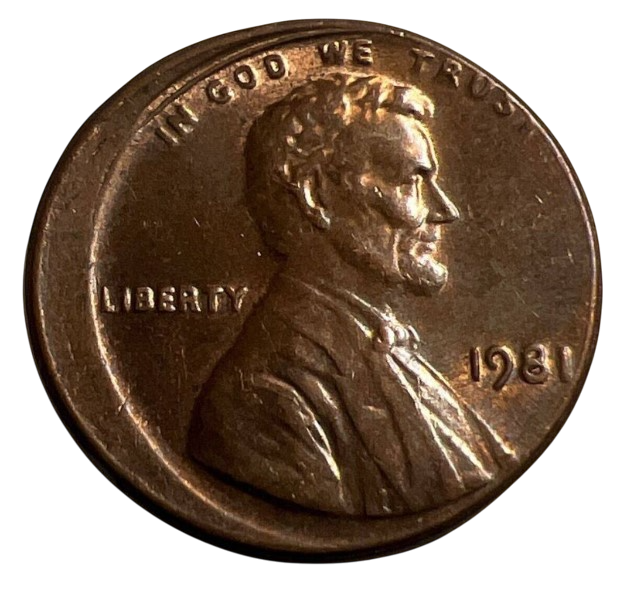
- Cause: Occurs when the coin blank (planchet) is not properly centered during the strike.
- Appearance: A portion of the design is missing, often showing a crescent moon-shaped blank area.
- Value: Varies widely; some 1981 pennies with slight off-center errors may be worth just a few dollars, but those with significant off-centering and visible date and mint mark can fetch up to $900 or more.
- Collector tip: The larger the off-center strike, the rarer and more valuable the coin tends to be.
Double Struck
- Cause: Happens when a coin is struck twice by the minting press.
- Appearance: The coin displays two overlapping images slightly offset, making the design look doubled.
- Value: Prices on the market, such as eBay, can reach up to $250, depending on the coin’s condition and how obvious the error is.
- Collector’s note: Larger, clearer double strikes usually command higher prices.
Re-punched Mint Mark (RPM)
- Cause: Occurs when the mint mark is punched more than once, leaving a visible doubling or shadow of the mint mark letter (such as D or S).
- Appearance: The mint mark looks duplicated or “shadowed” to the naked eye.
- Value: These 1981 penny RPM errors can typically be found for $200 to $400 on auction sites.
- Tip: RPMs are popular among collectors since mint marks are easy to spot and verify.
Where to sell your penny?
Now that you know the value of your penny, you might be wondering where to sell it. Don’t worry: here’s a guide to some of the best online platforms where you can easily sell your coins, along with their advantages and disadvantages.
Discover the best platforms for selling coins online (pros and cons).
FAQ about the 1981 Penny Value
1. What is the general market value of a circulated 1981 Lincoln penny?
Most circulated 1981 pennies are worth their face value — about 1 cent — because they were minted in very high quantities and have no significant rarity. However, coins in higher grades or with special characteristics can command a premium.
2. How much is an uncirculated (Mint State) 1981 penny worth?
Uncirculated 1981 pennies graded MS60 to MS63 generally range from $0.10 to $1. Higher-grade examples, especially those graded MS65 or better, can reach prices of $5 to $20 or more, particularly if they have a strong red color (full RD).
3. Does the mint mark affect the value of a 1981 penny?
Yes, but only slightly. The 1981 pennies were minted in:
- Philadelphia (no mint mark)
- Denver (D)
Both mint marks have large mintages and thus similar market values for common coins. Denver coins can sometimes be slightly more desirable for collectors seeking variety or stronger strike quality, but the price difference is usually minimal.
4. Are there any rare varieties or errors from 1981 that increase the coin’s value?
Yes. Notable varieties include:
- Doubled Die Obverse (DDO) (rare and minor)
- Repunched Mint Marks (RPM) on Denver coins
- Die cracks, cuds, and off-center strikes
Such error coins, especially when graded high, can sell for $20 to several hundred dollars, depending on severity and condition.
5. How does the color grading (Red, Red-Brown, Brown) influence the 1981 penny’s value?
- Red (RD) coins retain 95%+ original copper luster and are the most valuable.
- Red-Brown (RB) coins have moderate toning.
- Brown (BN) coins are heavily toned or circulated.
A Red MS65 1981 penny can fetch $10 to $30, while a Brown MS65 might only be worth $2 to $5.
6. What is the value range for 1981 proof pennies?
Proof pennies from the San Francisco mint (1981-S) are more collectible and usually worth $1 to $10 in typical conditions. High-grade proofs with deep cameo contrast (PR69DCAM or PR70DCAM) can command $15 to $50 or more.
7. Where can I get my 1981 penny professionally graded to maximize its value?
Professional grading companies such as PCGS (Professional Coin Grading Service) and NGC (Numismatic Guaranty Corporation) offer certification and grading that can greatly increase buyer confidence and coin value. For a 1981 penny, especially high-grade Red or error examples, grading is often worthwhile.


















































